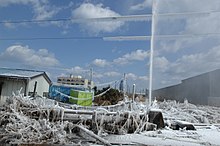frost
The term frost (German. Derivation of freeze ) describes the occurrence of temperatures below 0 ° C ( freezing point of water ), especially in the environment , which mainly affects living beings, water and soil. The permafrost of winter leads to the hibernation of nature .
Air frost and ground frost
Frost (also known as air frost to distinguish it from ground frost) in the sense of meteorology and climatology occurs when the air temperature at a height of two meters (meteorological measurement standard, measurement in the climate hut ) falls below zero degrees Celsius. That is why this type of frost is also known as hut frost in Switzerland .
A day on which the temperature minimum is below zero degrees Celsius is accordingly called a frost day .
Ground frost means that the temperature near the ground (usually 5 cm above the natural ground)dropsbelow freezing point . Ground frost can already occur on clear, windless nights when the air temperature at a height of two meters is still plus four degrees.
Soil that remains frozen all year round is called permanent or permafrost soil .
In the temperate latitudes , the following formulations are used to describe the temperature.
- light frost: –0.1 to –5.0 degrees Celsius
- moderate frost: –5.1 to –10.0 degrees Celsius
- severe / severe frost: -10.1 to -15.0 degrees Celsius
- very severe / strong frost: below –15.0 degrees Celsius
In addition, there is also the term low frost for temperatures down to –2 degrees Celsius. For days with severe frost, the term cold day is used in climatology - interpretable and not common in German-speaking countries .
Frost breaks: night, early and late frost
Frost as a weather event can be identified as follows:
- Frost days , with temperature events below 0 ° C
- Ice days when the temperature never rises above 0 ° C; the other frost days are called frost change days
If the temperature drops below 0 ° C (meteorological measurement standard) at a height of 2 m due to nocturnal radiation with a cloudless sky and in a sheltered location, we speak of night frost . These are microclimatic events.
Frost breaks are characteristic of winter as a season of the year which, in the custom of meteorology in Central Europe, includes the months of December, January and February, but occurs regularly throughout the winter half-year (i.e. mid-October to mid-April) - nevertheless, frost events can also occur after the end of the phenological winter ( i.e. the onset of the typical signs of vegetation for full spring) and occur in early and full autumn. As early frost in autumn, this can endanger crops ( potatoes , sugar beets ) or, as late frost in spring, it can damage fruit , viticulture and horticulture . The ability of a plant to withstand such frosts are called to frost .
Frost in the sea
In seafaring , the terms white frost ( English white frost ) and black frost ( black frost ) denote an icing of the ship superstructure. White frost arises from the spray when the sea ( salt water ) comes over in a strong storm , black frost arises from fog or drizzle ( fresh water ). Both can capsize the ship and overload the rigging.
Permafrost
The winter frost can last a few days or several months, depending on the region. In nature it leads to hibernation or dormancy , has direct influence on the dormancy of seeds and triggers the lap inhibition of crops by vernalization .
For road surfaces, among other things, it is particularly harmful if the temperatures fluctuate around freezing over a long period of time and it is also damp. The alternation between frost and thaw causes water to penetrate into tiny crevices and freeze there. Ice has a lower density than water, so it needs more space. It stretches the barely visible crevices a little with enormous force, so that a little more water fits in next time. After many repetitions, visible damage occurs and frost weathering occurs . In the case of unprotected water pipes , frost also leads to a water pipe rupture with the following water damage .
Frost warning
For various areas, such as agriculture and construction in particular , it is important to know in advance whether frost will form. For this reason, a frost warning is issued when frost is likely. The decisive factor here is the lowest nighttime temperature, which is calculated in advance using the dew point rule, for example . There are three different degrees, which are symbolized by stars:
- no night frost (*)
- Night frost possible ( * )
- Night frost very likely ( ** )
In agriculture, a blanket of snow offers the best frost protection in crop cultivation ; in late frosts in spring, frost protection irrigation is widely used to protect sensitive crops .
See also
Web links
Individual evidence
- ↑ Frost, Bodenfrost, Hüttenfrost On: SRF from September 25, 2018
- ↑ Frost . In: DWD Wetterlexikon (note: the larger / smaller signs are set the wrong way round).
- ↑ Black Frost: Diabolical Ice on Board. Fish steamer "Alemannia" narrowly escaped a disaster. seefunknetz.de, accessed on May 31, 2009 (excerpt from the bulletin of the German Maritime Museum Bremerhaven , 1/92. Author: Hans Wölbing, 1992).




